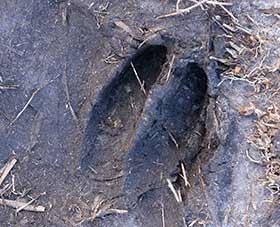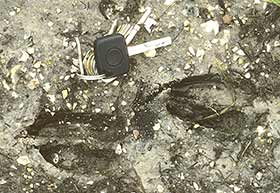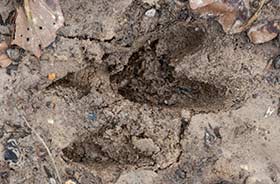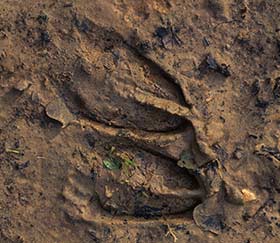Deer field signs - slots in the mud
Deer have cloven hooves, that is the hoof is divided into two parts known as the cleaves, which leave a clear incision in all but the hardest ground.
Once one knows what to look for, deer slots are largely unmistakable, and with practice, using size and shape as clues, can be a helpful indicator of the species concerned, particularly if used in conjunction with other field signs and a little knowledge of distribution and life style.
Beware, though, that distorted, misshapen prints are often left in really soft ground or when the deer slips on, for example, a bank or slope. Slot shapes can also vary with gait – a running deer’s cleaves will splay outwards, just as they do on soft ground.
Stated slot sizes for each species can also be misleading, as size is clearly related to the size of the animal, and that, of course, varies with age and sex. A red deer calf, for example, may be no bigger than an adult roe deer. Then to further add to the difficulties, a deer’s forefeet are sometimes larger than its hindfeet. Stated dimensions, then, can only be used as a general guide.
Deer slots can be confused with those of sheep and goats, but this need not be considered here, as neither is likely to be encountered on the Crown Lands of the New Forest.
Cattle and pigs, though, also have cloven hooves, and both do occur in the New Forest. But in contrast to the deer’s typically narrow slots, cattle slots are unmistakably large and rounded, whilst pigs often leave relatively small but markedly rounded slots that, again in contrast to deer, show clear signs of dew claws as marks either side of the main slot.
(Dew claws are small, claw-like digits positioned slightly higher up the leg and to the side of the hoof).
But despite the potential difficulties, an awareness of slot characteristics can be useful when considering the likely identity of the deer that have travelled along your path.
Fallow Deer

Fallow deer slots are slightly smaller than those of red deer, and narrower, more elongated.
Guide size: fallow deer buck, 6.5 - 8 centimetres (3 inches) long, 4 - 5 centimetres (1½ inches) wide; fallow deer doe, 5 - 6 centimetres (2 inches) long, 3 - 4 centimetres (1¼ inches) wide.
The shape left by each cleave often tends to be pointed at the front, and to have almost straight, parallel outer sides at the rear.
Red Deer

Guide forefoot size for a fully grown red deer stag: 8 - 9 centimetres (3½ inches) long, 6 - 7 centimetres (2½ inches) wide. For a fully grown red deer hind: 6 - 7 centimetres (2½ inches) long, 4 - 5 centimetres (1½ inches) wide.
The red deer slot is characterised by a rounded outline at the back of each cleave, whilst at the front, the outer edges of each curve symmetrically towards the tip.
Roe Deer

Roe deer slots are small, and often narrow and pointed at the end.
Guide size for an adult roe deer of either sex: 4 - 5 centimetres (1½ inches) long, 3 - 4 centimetres (1¼ inches) wide.
Sika Deer

Sika deer slots are very similar to those of fallow deer, but are often slightly shorter and broader.
Reeves muntjac
Muntjac slots are typically small and delicate, around 2.5 centimetres (1 inch) long, and sometimes with the outer cleave longer than the inner and with the tip of the outer just curving over the tip of the inner.
New Forest deer field signs - find out lots more
New Forest deer - find out lots more
References:
The History of British Mammals: Derek Yalden
Roe Deer: John K. Fawcett, British Deer Society
New Forest Roe Deer: John K. Fawcett
Deer Watch: Richard Prior
Mammals of Britain and Europe: David McDonald, Priscilla Barret
Field Guide to British Deer: F J Taylor Page
More links
Other related links
Search this site

Sadly, 58 animals were killed - 35 ponies, 13 cows, 8 donkeys and 2 sheep, whilst a further 32 were injured - 3 pigs, 9 donkeys, 11 cows and 9 ponies.
(Forty-three accidents occurred in daylight, 15 at twilight and 101 in the dark. Twenty-seven accidents were not reported by the driver involved).
Here's just one horrific example - Three donkeys killed in collision with van at notorious New Forest blackspot (Advertiser and Times)

